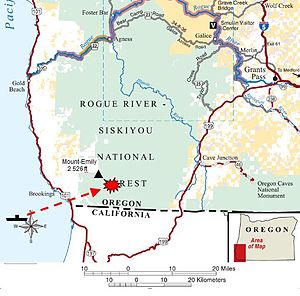Lookout Air Raids
| Lookout Air Raids | |||||||
|---|---|---|---|---|---|---|---|
| Part of the American theater and Pacific theater of World War II | |||||||
 Lookout air raid schema | |||||||
| |||||||
| Belligerents | |||||||
|
|
| ||||||
| Commanders and leaders | |||||||
| Keith V. Johnson |
Tagami Akiji Nobuo Fujita | ||||||
| Strength | |||||||
|
1 patrol of fire lookouts |
Sea: 1 American Theater (WWII) | ||||||
| |||||||
The Lookout Air Raids were minor but historic Japanese air raids that occurred in the mountains of Oregon, several miles outside Brookings during World War II.[1]
On September 9, 1942, a Japanese
Lookout Air Raids

On Wednesday morning, September 9, 1942, the
Howard "Razz" Gardner spotted and reported the incoming "Glen" from his fire lookout tower on
Although Razz did not see the bombing, he saw the smoke plume and reported the fire to the dispatch office. He was instructed to hike to the fire to see what suppression he could do. Dispatch also sent USFS Fire Lookout Keith V. Johnson from the nearby Bear Wallow Lookout Tower.[citation needed] Fujita dropped two bombs, one on Wheeler Ridge on Mount Emily in Oregon. The location of the other bomb is unknown. The Wheeler Ridge bomb started a small fire 16 km (9.9 mi) due east of Brookings.[6]
The two men proceeded to the location and were able to keep the fire under control. Only a few small scattered fires were started because the bombs were not dropped from the correct height.[
Aftermath

A full investigation was launched by the Federal Bureau of Investigation, which resulted in locating several bomb fragments. The story was reported in several newspapers on September 10, 1942.[citation needed] Lieut. Gen. John L. DeWitt, the area commander announced,
The Western Defense Command is investigating the circumstances surrounding the discovery on Sept. 9 of fragments of what appears to have been an incendiary bomb. These fragments were found by personnel of the United States Forestry Service near Mt. Emily nine miles northeast of Brookings, Or. Markings of the bomb fragments indicated that the missile was of Japanese origin.[2]
The floatplane carried two bombs. Both were dropped, according to the Japanese records, but no trace has yet been found of the second bomb.[citation needed] One of the bombs left a foot-deep crater.[2] Fujita and his observer made a second attack on September 29, again causing only negligible damage.[citation needed]
Postwar
Twenty years later, Fujita was invited back to Brookings. Before he made the trip the
See also
Notes
- ^ As well as only the second time in history that the contiguous U.S. was bombed by someone working for a foreign power, the first being the bombing of Naco, Arizona by Patrick Murphy, although the Murphy bombing inside the U.S. was an accident.
References
- ^ a b Bingham, Larry (2008-10-02). "Oregon coast trail dedicated for World War II bombing". The Oregonian. Retrieved 2009-02-04.
- ^ a b c Jap Incendiary Sets Forest Fire. DeWitt's Announcement Hints Raider May Have Been Launched From Submarine Off Coast, Later Attacked by Patrol Planes
- ^ The Journal of military history, Volume 53, p. 172. Virginia Military Institute, American Military Institute, George C. Marshall Foundation, 1989
- ^ CBS News. Steve Hartman. A Soldier's Story: Steve Hartman Talks To An Oregon Veteran
- ^ Mochitsura Hashimoto (1954). Sunk.
- ISBN 978-0875952369.
- ^ Burel, Patty (2008-09-19). "Trail Dedication at Japanese Bombing Site Set". FS Today. Archived from the original on 2015-10-03. Retrieved 2011-09-07.
- New York Times. Retrieved 2009-03-04.
